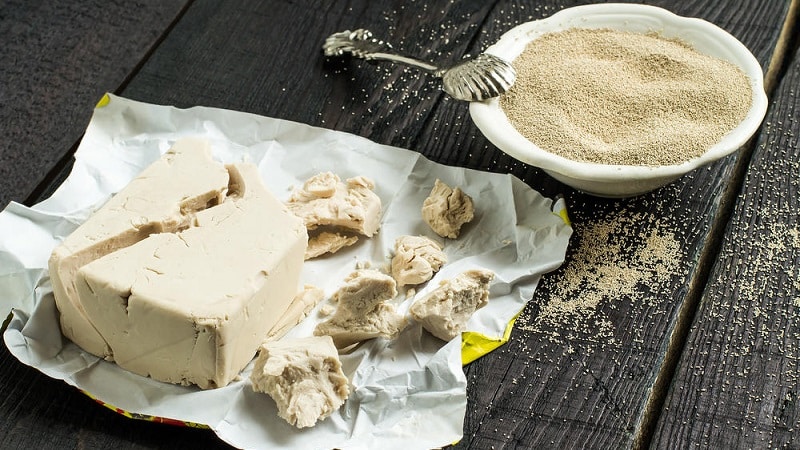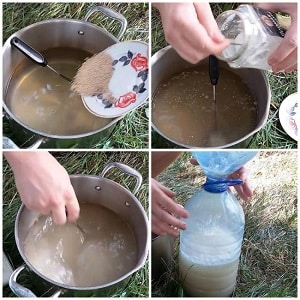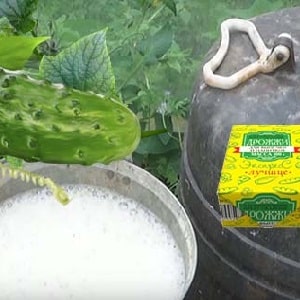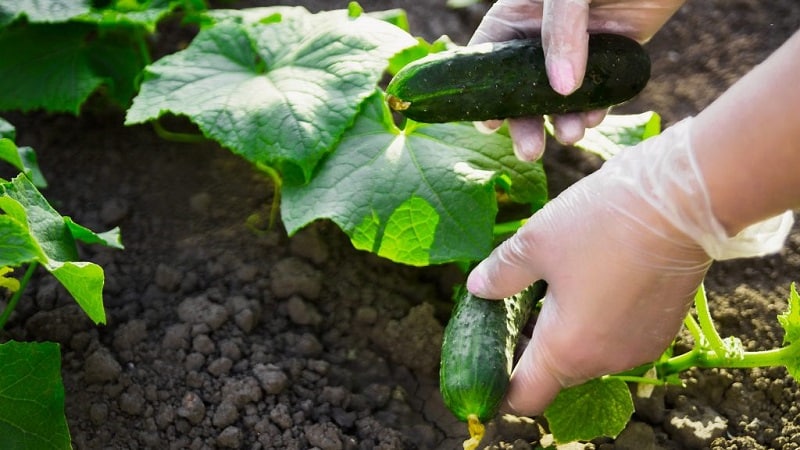The benefits of fertilizing cucumbers with yeast and how to apply it correctly
For good yield, cucumbers require various fertilizers, including yeast. The popular food product is rich in substances useful for vegetable crops. Bushes are watered with this solution both in the greenhouse and in the open ground.
What are the benefits of yeast for cucumbers?
This food product, consisting of single-celled fungi of the Saccharomyces class, is rich:
- amino acids;
- vitamins, especially group B;
- proteins;
- minerals and trace elements, in particular iron.

The use of such fertilizing not only improves the condition of plants, but also enriches the soil. After watering with yeast solution, the content of beneficial microorganisms and elements in the soil increases.
Fertilize seedlings and adult plants with the product at any stage of development.
Positive effect from the use of yeast manifests itself in:
- activation of root system growth;
- improving the quality of green mass (improving the color of leaves, increasing their volume);
- strengthening the immunity of seedlings, increasing their resistance to adverse weather conditions;
- better development of cucumber vines;
- faster adaptation of seedlings to new conditions after picking;
- stimulation of crop growth;
- improving soil composition.
Thanks to yeast feeding cucumbers in a greenhouse tolerate lack of light more easily.
When a baking product is diluted in water, fungi release mesoinositol alcohol, biotin, and vitamin B1.These substances stimulate root formation and activate phytohormones, which accelerate the regeneration process of plant cells.

The entry of active yeast fungi into the soil creates favorable conditions for microorganisms that process organic matter. As a result, the soil is saturated with nitrogen, phosphorus and other microelements in a form easily digestible for plants.
Important! This fertilizer is used only in the warm season. Otherwise, there will be no benefit from fungi.
When is feeding required?
Yeast is added if:
- seedling material is weak, plant stems are thin;
- seedlings after picking do not take root well and do not take root;
- bushes do not form foliage well;
- the lashes are underdeveloped;
- in a greenhouse, seedlings cannot tolerate a lack of light;
- there are unfavorable weather conditions;
- the soil is infertile.
Take note:
Feeding recipes for a better harvest of cucumbers
How to water cucumbers with soda and what is the benefit of it
The benefits of potassium nitrate for cucumbers during the fruiting period
Fertilizer application timing
 They begin to apply fertilizing already at the seedling stage in the spring.
They begin to apply fertilizing already at the seedling stage in the spring.
For young seedlings, fertilizer is used three times:
- when 2 true leaves appear;
- when transplanting seedlings from a common container into separate pots with a new soil mixture;
- on the eve of planting in the garden.
Freshly prepared product is used for seedlings. It should not be multi-component.
The validity period of such fertilizer for cucumbers it is 2 months. It is also used for adult plants during the formation of ovaries and fruiting.
The positive effect appears within 3 days. The last fertilizing stimulates re-flowering, allowing you to harvest twice a season.
Important! An excess of yeast (more than 3 feedings over the summer) is harmful to cucumbers.In this case, they will not give a good harvest.
Best Recipes
To prepare natural fertilizer use fresh yeast, both dry and wet. You can replace them with a bakery product that contains this ingredient.
Reference. Hops enhance the effect of fungi and activate fermentation. An additive in the form of several grains of potassium permanganate prevents diseases from affecting plants.
With water and sugar
 Sugar ensures better fermentation. Preparation of the product is simple:
Sugar ensures better fermentation. Preparation of the product is simple:
- 10 g of yeast are diluted in 10 liters of warm water.
- Add 50 g of sugar to the solution.
- Infuse everything in a warm room, in a closed container, for at least 2-3 hours.
For irrigation, the solution is diluted with water in a ratio of 1:5.
In another version a mixture of 10 g of yeast, 3 liters of water and a small amount of granulated sugar is kept in a closed jar for 7 days. The solution is pre-diluted with water: take 10 liters of liquid per 250 ml of product.
Reference. The mixture avoids the formation of barren flowers.
With dairy products
Milk will protect crops from diseases and pests. Take only fresh, unboiled product.
To prepare the product 100 g of live yeast are diluted in 1 liter of milk. The resulting mixture is stirred and left to ferment for 2 hours. The concentrate is diluted in 10 liters of water. Fertilizer is poured at the root or used to spray the leaves.
Dry yeast infusion
Add 100 g of dry yeast to a bucket of warm water (up to +38°C) and leave for 1 day to obtain a nutrient liquid, which is used to water the plants at the root. Use 0.5 liters of the composition per bush.
The product is also combined with other growth stimulants.. 10–12 g of dry yeast and 2 g of ascorbic acid are poured into 5 liters of water. The mixture is infused for 5–7 days in a dark place.The finished solution is diluted with water (proportion - 250 ml per 10 l).
With ash
 Wood ash contains:
Wood ash contains:
- calcium - 40%;
- potassium - 12%;
- phosphorus - 6%;
- trace elements (boron, iron, manganese, magnesium, sulfur, zinc, molybdenum, copper).
She creates favorable conditions in the soil for reproduction of nitrogen-fixing nodule bacteria.
To prepare the fertilizer take 100 g of sugar, wood ash and yeast, pour 3 liters of warm water, mix and leave in a dark place for 3 days. The finished mass, without filtering, is diluted with water in a ratio of 1:40.
With herbal infusion
In a large container pour a bucket of finely chopped freshly cut grass, add 1 crushed loaf of bread (rye and blue bread are suitable) and 500 g of live yeast. The resulting mixture is poured into 50 liters of water and left warm for 3 days.
Reference. To make the bushes grow faster, it is recommended to water them with this product throughout the season.
Another fertilizer option:
- Finely chop 1 kg of nettle, clover, sow thistle, datura, henbane, dandelions, chamomile inflorescences and stems, add 100 g of yeast.
- Fill in all 10 liters of water.
- Leave for a week, stirring occasionally.
- Strain and dilute with water in a ratio of 1:5.
The product is poured under the roots of plants at the rate of 3–5 liters per 1 m².
Read also:
Recipes for feeding cucumbers in a greenhouse for a rich harvest
Treatment of cucumbers with whey and iodine: recipes and proportions
How to feed
In order for the product to bring more benefits to cucumber bushes, it is used correctly depending on the growing conditions of the crop.
Peculiarities
 Basic Rules:
Basic Rules:
- the yeast-based composition is applied after abundant watering of the crop;
- more than 3 feedings over the summer are not used;
- use only fresh product;
- do not water the plants with the solution immediately after picking;
- use only warm liquid, pour it under the root;
- Do not use yeast at the same time as organic matter;
- Make a fresh mixture every time.
In the open ground
Plants in unprotected conditions watered with the product from the early stages of the growing season:
- do not feed the bushes in the heat;
- apply fertilizer only to heated soil;
- after planting in the garden, yeast is used no earlier than 10 days later;
- water only in the evening;
- When the air temperature is below +15°C, fertilizing is not used.
Excess of this product threatens the rapid growth of green mass in cucumbers and prevents fruit set.
In the greenhouse
Cucumber bushes in a greenhouse fertilize with yeast 2-3 times during the summer.
The product is used 10 days after the main feeding:
- on the eve of flowering, add 200 g of cow manure or bird droppings per 10 liters of water;
- when the ovaries appear, use “Nitrophoska”.
For the third time, the cucumber bushes are fed yeast after the first wave of harvest.

Reviews
Reviews from gardeners about yeast feeding are positive.
Tatyana, Moscow region: “Every year I feed greenhouse cucumbers with yeast. You won't find a better fertilizer! I water the seedlings with a solution containing tobacco dust. It stimulates plant growth. When the ovaries appear, I use an infusion of herbs; during the fruiting period, I use a product with ash. Thanks to this, vegetables ripen faster.".
Valentina, Blagoveshchensk: “I want the cucumbers to be less sick and affected by fungi, which is why I water them. Sometimes I just scatter crackers on the garden bed. This method also works".
Mikhail, Moscow: “A two-day yeast infusion of nettle is an excellent means for the growth of cucumber seedlings. I use it as a fertilizer if the leaves begin to wilt or turn yellow.".
Conclusion
Yeast is a natural, environmentally friendly fertilizer that is easily absorbed by plants. To get a good harvest of cucumbers, it is important to use this fertilizer correctly. The product protects bushes from diseases, improves fruiting, growth of green mass and roots.